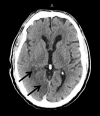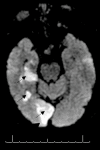Lambl's Excrescences Associated with Cardioembolic Stroke
- PMID: 35314665
- PMCID: PMC8948441
- DOI: 10.12659/AJCR.934859
Lambl's Excrescences Associated with Cardioembolic Stroke
Abstract
BACKGROUND Lambl's excrescences (LE) are threadlike fronds that occur along valve closure lines where minor endothelial damage occurs, resulting in thrombus formation. It is often asymptomatic but can result in cerebral embolism and coronary artery obstruction. The criterion standard for diagnosis is transesophageal echocardiography. CASE REPORT We report an interesting case of a 73-year-old right-handed man presenting with a visual disturbance. An MRI head demonstrated an acute-to-subacute infarct in the right posterior cerebral artery territory involving the posterior right temporal, right occipital lobes, and right thalamus, which was in keeping with embolic stroke. Investigation with transthoracic and transesophageal echocardiography showed echo density on the ventricle surface of the left coronary cusp, which was concerning for Lambl's excrescences, with no significant arrhythmia on his implantable loop recorder at 3-month follow-up. Therefore, we believe that his stroke was due to embolization from Lambl's excrescences. Since this was his first episode of stroke, monotherapy with aspirin was continued. CONCLUSIONS Although rare, Lambl's excrescences should be considered in the differential diagnosis of embolic stroke. However, there is no established guideline for its management. Patients with the first stroke episode can be treated conservatively with antiplatelet therapy. In patients with recurrent ischemic events, anticoagulation should be offered, along with discussion about surgical excision.
Conflict of interest statement
Figures



References
-
- Kariyanna PT, Jayarangaiah A, Rednam C, et al. Lambl’s excrescences and stroke: A scoping study. Int J Clin Res Trials. 2018;3(2):127. - PubMed
-
- Ornello R, Degan D, Tiseo C, et al. Distribution and temporal trends from 1993 to 2015 of ischemic stroke subtypes: A systematic review and meta-analysis. Stroke. 2018;49(4):814–19. - PubMed
-
- Roldan CA, Shively BK, Crawford MH. Valve excrescences: Prevalence, evolution and risk for cardioembolism. J Am Coll Cardiol. 1997;30(5):1308–14. - PubMed
-
- Leitman M, Tyomkin V, Peleg E, et al. Clinical significance and prevalence of valvular strands during routine echo examinations. Eur Heart J Cardiovasc Imaging. 2014;15(11):1226–30. - PubMed
Publication types
MeSH terms
LinkOut - more resources
Full Text Sources
Medical

